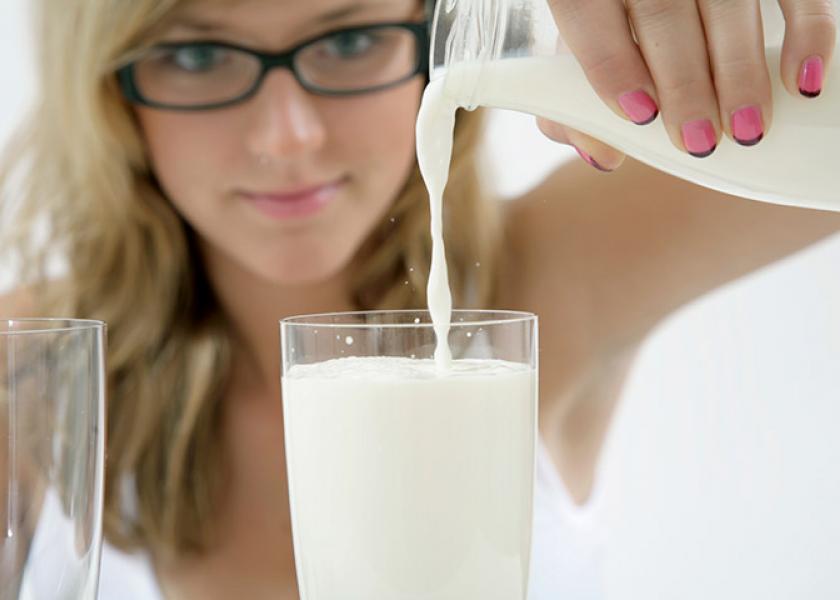Prairie Fare: Have You Applauded a Cow Lately?

Cows produce about 90 glasses of milk per day, or enough to quench the thirst of 30 children with three glasses of milk daily. During a cow’s lifetime, that’s 200,000 glasses of milk.
By: Julie Garden-Robinson, Food and Nutrition Specialist, NDSU Extension Service
As I finished my glass of ice-cold milk, I thought about my now 20-year-old son’s comments many years ago. He always has enjoyed milk. When he was a toddler, we would hear his tiny voice saying “want milk” in the early morning hours. He wanted his milk and cereal pronto.
One day, as our toddler gazed into our backyard through our window and clapped his hands, he announced excitedly, "See cow! See cow!"
I rushed to the window to see what was happening. Cows are not allowed in backyards in the city.
A rabbit was grazing in our backyard. Granted, it was a pretty big bunny.
That’s how we learned that our child called all animals "cows." We began collecting stuffed animal cows for his bedroom, which had wallpaper adorned with various dancing farm animals, including his favorite animal.
Cows are amazing animals. They eat quite a bit, but they also produce lots of milk.
A cow’s yearly menu includes an estimated 2.5 tons of hay, 6.5 tons of silage, a couple of acres of grass and as much as 7,000 gallons of water. Cows, in turn, produce about 90 glasses of milk per day, or enough to quench the thirst of 30 children with three glasses of milk daily. During a cow’s lifetime, that’s 200,000 glasses of milk.
Fluid milk is used to make many other dairy products. A pound of butter requires about 39 cups of milk, a pound of American cheese requires 19 cups of milk, and 1 cup of milk is needed to produce 8 ounces of yogurt.
Milk is a nutrient-rich food, with a wide variety of naturally occurring nutrients, compared with the number of calories. Milk is an excellent source of calcium (300 milligrams per cup), plus it naturally contains protein, riboflavin, magnesium, potassium, vitamin B-12, phosphorus and other nutrients. Vitamin D is added to fluid milk because it helps the body use the calcium in milk to build and maintain bones.
On the other hand, many milk-type beverages, including almond, coconut and rice milk are available. They differ in naturally occurring nutrients and cost.
The calcium, riboflavin and vitamin B-12 in almond, coconut and rice milk are not naturally present. The milk-type beverages also provide far less muscle-maintaining protein. Milk has 8 grams of protein per 8-ounce glass, while most almond, coconut and rice “milk beverages” have, at most, 1 gram protein per 8-ounce glass.
On average, cows’ milk costs 26 cents per 8-ounce serving, compared with almond milk at 41 cents, coconut milk at 62 cents and rice milk at 43 cents. These beverages contain less protein, and the calcium, riboflavin, vitamin B-12 and other nutrients are added as a means to fortify the milk to be comparable to cows’ milk.
Consuming adequate calcium is especially important during the bone-building years of childhood. Children ages 4 to 8 need 800 milligrams of calcium per day, or about three cups of milk or other calcium-rich foods. Nine- to 18-year-old children need 1,300 milligrams of calcium in their daily diet.
Should everyone get their calcium from milk? People with milk allergies must avoid all milk products for medical reasons. Food product ingredient statements are labeled with allergens. For people with allergies, alternative calcium-containing foods and beverages are essential.
On the other hand, some people have lactose intolerance, which is different from a milk allergy. Those with lactose intolerance have trouble digesting milk sugar or lactose and feel bloated or experience stomach upset after drinking milk. Research has shown that many people with lactose intolerance can drink some milk if they try smaller amounts and drink it along with meals.
Aged cheeses and dairy products with active cultures usually are tolerated by those with lactose intolerance. Low-lactose products are available, as are chewable tablets that you can take before eating dairy. If you think you have allergies or intolerances, check with a healthcare provider for the appropriate diagnosis.
Let’s applaud the work of dairy cows and dairy farmers during June, National Dairy Month. Try this tasty and colorful pizza with a leafy green salad, some fresh strawberries and a glass of ice-cold milk for a complete meal.
For more information about nourishing your bones, check out “Nourishing Boomers and Beyond” at http://www.ndsu.edu/boomers for nutrition resources and recipes.
Cheesy Tortilla Mini Pizzas
- 4 6-inch flour tortillas
- 1/2 c. chunky-style medium salsa
- 1/2 c. reduced-fat mozzarella or Monterey Jack cheese
- 1/2 c. chopped green pepper
- 1/2 c. frozen corn kernels, thawed
- 1/4 c. chopped red onion
- 1/4 c. shredded sharp cheddar cheese
Preheat the oven to 350 F. Place tortillas on a baking sheet. Bake for about seven minutes, until crisp. Remove from oven and top each tortilla with about 2 tablespoons of salsa and 2 tablespoons of cheese. Sprinkle with green pepper, corn and red onion; top with cheddar cheese. Bake about five minutes, until cheese melts.
Makes four servings. Each serving has 150 calories, 4 grams (g) of fat, 7 g of protein, 20 g of carbohydrate, 3 g of fiber and 410 milligrams sodium.







